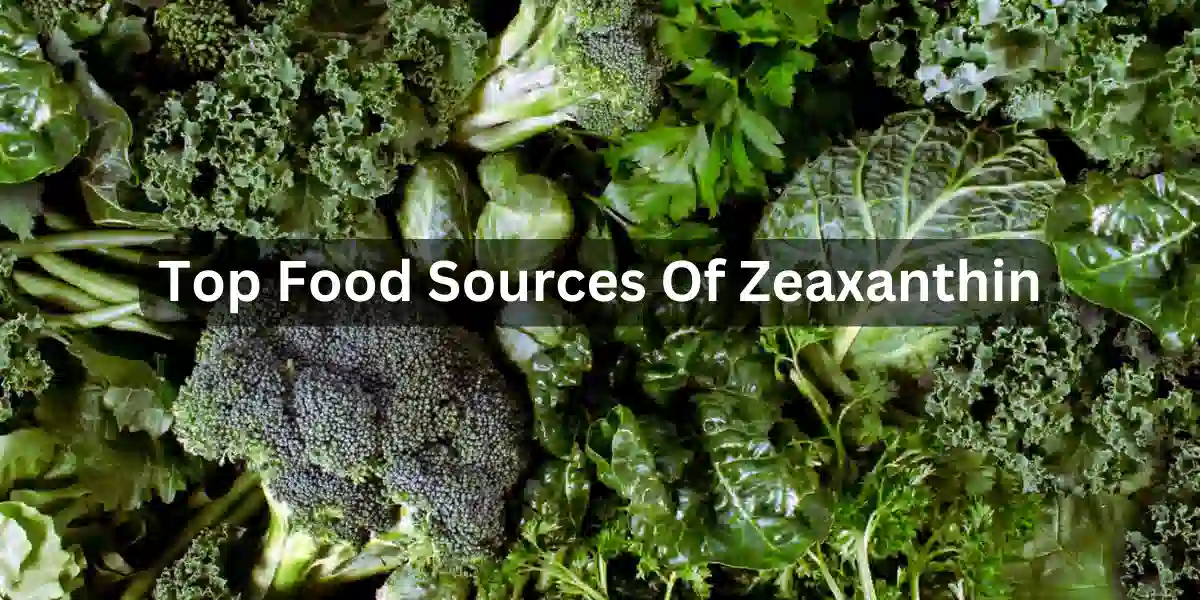Whether it is fruit or vegetable the naturally occurring pigment known as zeaxanthin belongs to the carotenoid family. The spotlight in this huge nutritional area has begun lighting up for this newcomer star and more could be yet to come.
Known for its ability to help promote good eyesight and prevent age-related macular degeneration (AMD) zeaxanthin is quickly gaining attention as a center of interest among those who pursue integrative approach.
this thorough exploration for example will explore the many facets of zeaxanthin’s benefits and discuss appropriate considerations when determining dosage. Last but not least we shall navigate the myriad of food sources that help us enjoy this important nutrient conveniently in our daily lives.
Can Zeaxanthin Improve Vision? Benefits Of Zeaxanthin
Zeaxanthin can help protect your eyes from harmful high-energy light waves like ultraviolet rays in sunlight.

Eye Health
With eye health in the retina’s macular region playing an important role, zeaxanthin features pivotal benefits at its forefront. Zeaxanthin is an important antioxidant that protects the eyes from a variety of risky high-frequency light waves, especially ultraviolet rays. New studies even suggest that a high intake of zeaxanthin may reduce the risk of age-related macular degeneration which is one leading cause of vision loss among older people.
Antioxidant Properties
Besides its ocular-centered benefits, zeaxanthin also functions as a powerful antioxidant. It collaborates with other oxidants to exhaustively capture and neutralize free radicals throughout the body. zeaxanthin relieves stress caused by free radicals that can damage cells and offer protection from a range of chronic diseases.
Skin Health
Curiously zeaxanthin gives benefits not only to the eyes and internal health but also to the skin. But it is not a substitute for sunscreen; rather research suggests that zeaxanthin may help protect the skin against harmful UV rays and therefore improve the overall complexion.
Dosage Recommendations
It is very complicated and depends among things on a person’s age as well as their health status. There are also different levels of nutrition requirements of people in varying circumstances or when eating foods with varying nutrient content. Because no official recommended dietary allowance (RDA) for zeaxanthin has yet been established, general guidelines indicate that a daily intake of 2 to 4 milligrams be consumed by adults.
Nonetheless, the different requirements of individual patients mean that consultation with health professionals is required to work out an accurate dosage appropriate for each patient’s unique state of body and mind.
Also important to recognize is that existing health conditions, medications, and lifestyle choices can affect zeaxanthin requirements. therefore healthcare professionals are well placed to shape advice that meets an individual’s comprehensive health requirements.
What Is The Best Source Of Zeaxanthin? Top Food Sources Of Zeaxanthin

Leafy Greens
Leafy greens like kale spinach and collard greens are the dietary staples in this zeaxanthin play. These turf powerhouses are not only a treasure trove of essential nutrients; they also abound in zeaxanthin. By regularly eating these vegetables one can greatly increase their daily zeaxanthin intake.
Eggs
The unpretentious egg in particular its yolk becomes a lowly but convenient and accessible zeaxanthin source. Not only does egg zeaxanthin content increase but by picking eggs from pasture-raised or omega-3 enriched sources one can also get the added benefit of extra nutrients. Therefore eggs can be considered a practical approach to improving zeaxanthin intake in balanced diets.
Corn
A dietary staple everywhere sweet as well as nutritious corn not only furnishes its unique flavor but also contains a high concentration of zeaxanthin. As both a flavoring and nutritious addition to the diet corn and its byproducts. (cornmeal and corn oil) can be real boons when used appropriately.
Orange Bell Peppers
Among the many colors of bell peppers their orange spearheads in particular are both visually appealing and delightful rich sources of zeaxanthin. So besides adding some color to meals these brightly colored vegetables also fortify the eyes and the immune system.
Goji Berries
A lesser-known but powerful source of zeaxanthin is the goji berry. These small red berries are rich in zeaxanthin as well. They also contain other antioxidants and essential nutrients that pack a punch too! A tasty way to add variety to zeaxanthin sources is by putting goli berries into snacks or smoothies.
Conclusion
In summation, zeaxanthin therefore turns out to be a nutritional dynamo of broad import for ocular welfare, antioxidant protection, and general well-being. Its presence in many forms of food offers people the ability to enjoy its benefits through a varied diet. In the tricky territory of zeaxanthin supplementation, one size does not fit all.
The need for individualized recommendations cannot be overemphasized. the private part of body images integrating foods rich in zeaxanthin into our everyday lives and adopting a comprehensive model of health will help us tap the vast potential that this important carotenoid provides.
Frequently Asked Questions
Q1: What is zeaxanthin and why does it matter?
Zeaxanthin belongs to the carotenoid plant pigment that creates color in fruits and vegetables. Good for the eyes; prevents retina damage due to harmful light waves; powers antioxidants.
Q2: What are the main effects of zeaxanthin?
Zeaxanthin is associated with several key benefits:
Eye health: zeaxanthin is concentrated in the macula of the retina and it helps prevent age-related macular degeneration (AMD) while supporting general eye health.
anti-oxidant properties: zeaxanthin is also an antioxidant; it neutralizes free radicals helps to prevent oxidative stress and aids in the prevention of chronic disease.
Skin health: zeaxanthin according to some studies may support healthy skin by protecting against excessive UV exposure ( but it is not a sunscreen).
Q3: Should I consume how much zeaxanthin daily?
However, there is no official recommended dietary allowance (RDA). A daily intake of 2 to 4 milligrams is usually recommended for adults. However, it is advisable to first seek the advice of a clinician for proper dosage according to one’s health profile.
Q4: Where does zeaxanthin come from?
Zeaxanthin is present in many foods including leafy greens (kale and spinach) eggs (particularly the yolk) corn or its products like cornmeal oil, orange bell peppers, and goji berries.
Q5: Can I instead take zeaxanthin supplements?
Of course, many popular formulas are available as supplements. But in principle, nutrition should be obtained from a balanced diet composition. Under the care of a medical professional for example, if you have special illnesses or dietary restrictions to consider. You may need to take supplements in addition to your normal food intake.
References
- Sources, health benefits, and biological properties of zeaxanthin
https://www.sciencedirect.com/science/article/abs/pii/S092422442100577X - Lutein and Zeaxanthin—Food Sources, Bioavailability and Dietary Variety in Age-Related Macular Degeneration Protection
https://www.ncbi.nlm.nih.gov/pmc/articles/PMC5331551/ - Zeaxanthin: Metabolism, Properties, and Antioxidant Protection of Eyes, Heart, Liver, and Skin
https://www.ncbi.nlm.nih.gov/pmc/articles/PMC6770730/